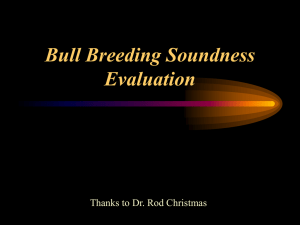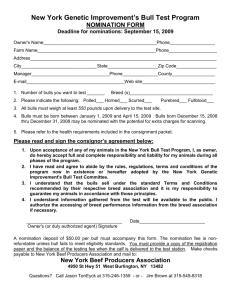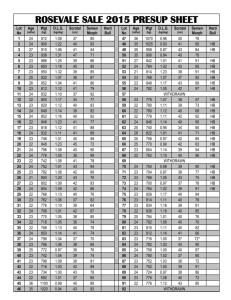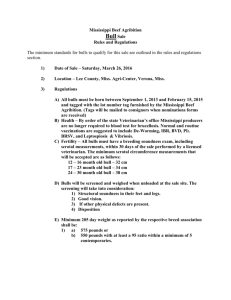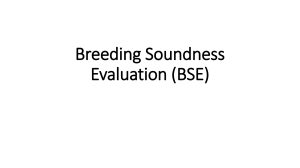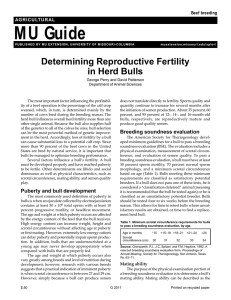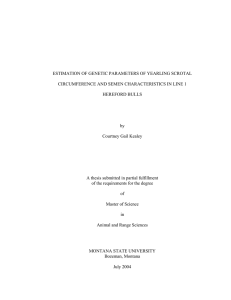BREEDING SOUNDNESS EXAMINATION OF BULLS
advertisement
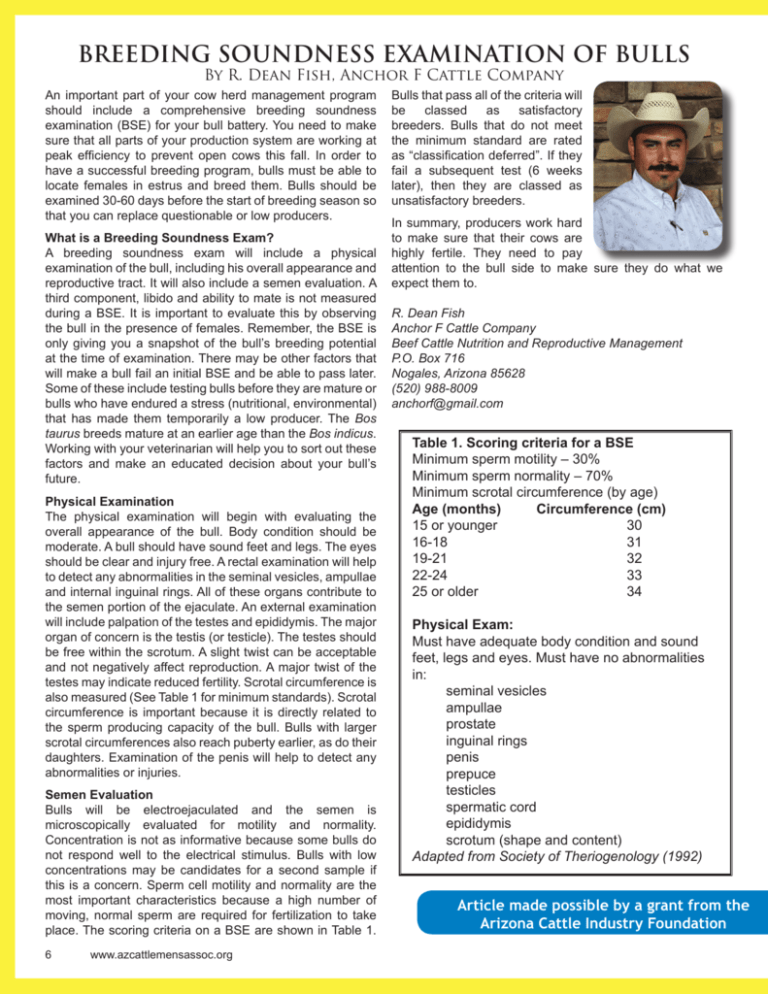
BREEDING SOUNDNESS EXAMINATION OF BULLS By R. Dean Fish, Anchor F Cattle Company An important part of your cow herd management program should include a comprehensive breeding soundness examination (BSE) for your bull battery. You need to make sure that all parts of your production system are working at peak efficiency to prevent open cows this fall. In order to have a successful breeding program, bulls must be able to locate females in estrus and breed them. Bulls should be examined 30-60 days before the start of breeding season so that you can replace questionable or low producers. What is a Breeding Soundness Exam? A breeding soundness exam will include a physical examination of the bull, including his overall appearance and reproductive tract. It will also include a semen evaluation. A third component, libido and ability to mate is not measured during a BSE. It is important to evaluate this by observing the bull in the presence of females. Remember, the BSE is only giving you a snapshot of the bull’s breeding potential at the time of examination. There may be other factors that will make a bull fail an initial BSE and be able to pass later. Some of these include testing bulls before they are mature or bulls who have endured a stress (nutritional, environmental) that has made them temporarily a low producer. The Bos taurus breeds mature at an earlier age than the Bos indicus. Working with your veterinarian will help you to sort out these factors and make an educated decision about your bull’s future. Physical Examination The physical examination will begin with evaluating the overall appearance of the bull. Body condition should be moderate. A bull should have sound feet and legs. The eyes should be clear and injury free. A rectal examination will help to detect any abnormalities in the seminal vesicles, ampullae and internal inguinal rings. All of these organs contribute to the semen portion of the ejaculate. An external examination will include palpation of the testes and epididymis. The major organ of concern is the testis (or testicle). The testes should be free within the scrotum. A slight twist can be acceptable and not negatively affect reproduction. A major twist of the testes may indicate reduced fertility. Scrotal circumference is also measured (See Table 1 for minimum standards). Scrotal circumference is important because it is directly related to the sperm producing capacity of the bull. Bulls with larger scrotal circumferences also reach puberty earlier, as do their daughters. Examination of the penis will help to detect any abnormalities or injuries. Semen Evaluation Bulls will be electroejaculated and the semen is microscopically evaluated for motility and normality. Concentration is not as informative because some bulls do not respond well to the electrical stimulus. Bulls with low concentrations may be candidates for a second sample if this is a concern. Sperm cell motility and normality are the most important characteristics because a high number of moving, normal sperm are required for fertilization to take place. The scoring criteria on a BSE are shown in Table 1. 6www.azcattlemensassoc.org Bulls that pass all of the criteria will be classed as satisfactory breeders. Bulls that do not meet the minimum standard are rated as “classification deferred”. If they fail a subsequent test (6 weeks later), then they are classed as unsatisfactory breeders. In summary, producers work hard to make sure that their cows are highly fertile. They need to pay attention to the bull side to make sure they do what we expect them to. R. Dean Fish Anchor F Cattle Company Beef Cattle Nutrition and Reproductive Management P.O. Box 716 Nogales, Arizona 85628 (520) 988-8009 anchorf@gmail.com Table 1. Scoring criteria for a BSE Minimum sperm motility – 30% Minimum sperm normality – 70% Minimum scrotal circumference (by age) Age (months) Circumference (cm) 15 or younger 30 16-1831 19-2132 22-2433 25 or older34 Physical Exam: Must have adequate body condition and sound feet, legs and eyes. Must have no abnormalities in: seminal vesicles ampullae prostate inguinal rings penis prepuce testicles spermatic cord epididymis scrotum (shape and content) Adapted from Society of Theriogenology (1992) Article made possible by a grant from the Arizona Cattle Industry Foundation

